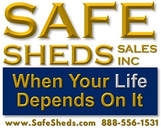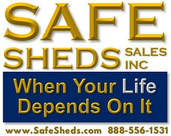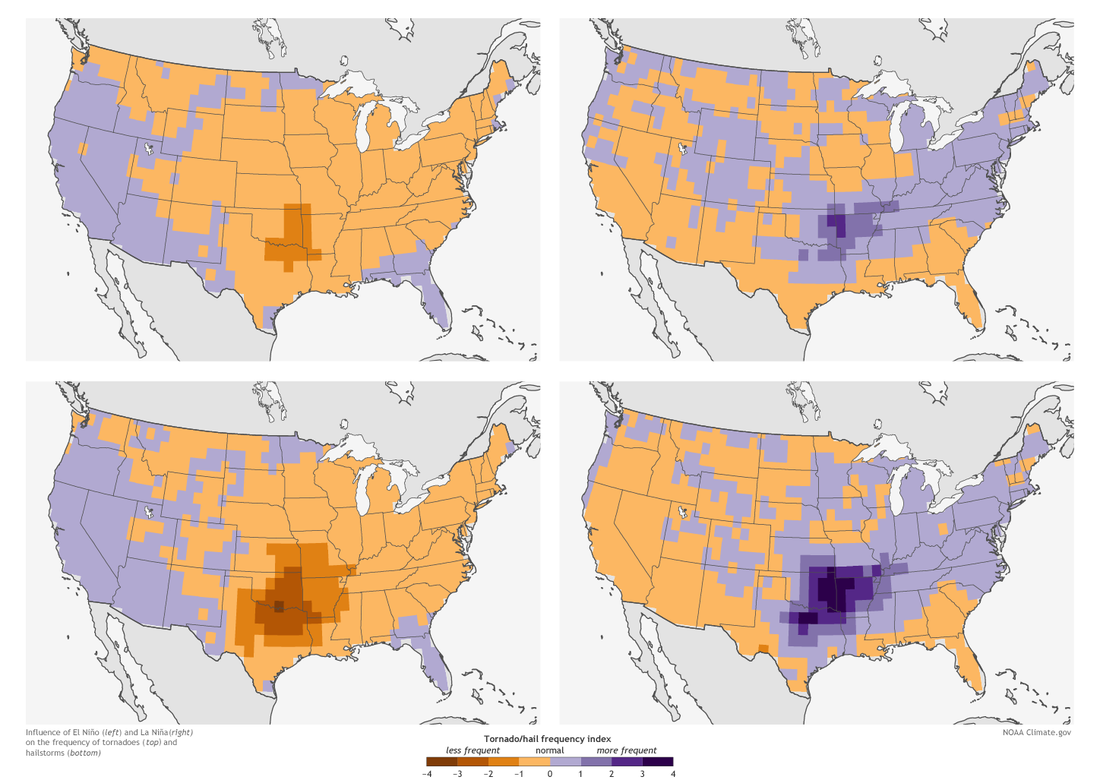 The National Oceanic and Atmospheric Administration (NOAA) has released its 2017-2018 winter weather predictions, and that might give us a clue about what kind of severe weather we may face next spring when tornado season fires up. NOAA is predicting warmer-than-average winter temperatures for large sections of the United States from California, across the Midwest, and upwards into Maine. The Pacific Northwest and Alaska are predicted to have a colder-than-normal winter, with a skinny strip of average winter weather forming a "belt" across a narrow part of the country. But can winter weather predictions tell us anything about what to expect during the 2018 tornado season? Actually...yes. (This is a great detailed article about how the science works!) That's because NOAA is also predicting a 55% to 65% chance of the development of a La Niña before winter sets in. La Niña weather in the winter causes hot, humid air to concentrate over the southern Plains states. That hot humid air sets up a strong north-south temperature divide that is the catalyst for spring storms as fronts move across the U.S. from the west and encounter the temperature divide. Severe weather like hailstorms and tornadoes were fewer in the spring of 2012 - 2016, years that had El Niño or neutral winters (El Niño is the opposite weather pattern as La Niña patterns). But 2017 was a very active spring with many severe storms and tornadoes that followed a La Niña winter weather pattern. If NOAA's prediction of the development of a La Niña this winter, the data shows that states like Texas, Oklahoma, Arkansas, and Louisiana could be headed for a rough spring. Hurricane Harvey just pummeled Texas and Hurricane Irma is predicted to strike Florida in the next 24 hours as a Category 4 or 5 storm. This is just the beginning of what's shaping up to be the most costly and dangerous hurricane season the U.S. has seen in many years.
Here at Safe Sheds, we've seen a huge increase in the number of phone calls and e-mails asking about using Safe Sheds shelters for hurricane protection. Our shelters are engineered and built to withstand Category 5 winds and provide protection against the tornadoes that are frequently spawned as these monster storms advance. But there are a couple of things you need to know if you're considering adding a Safe Shed, or any other storm shelter, to your family's emergency plans. 1) While a Safe Shed will withstand Cat 5 hurricane force winds and EF5 tornadoes, it is not water tight. In order to provide adequate ventilation and air flow for human and animal occupants, air must be able to enter the shelter. Making the Safe Shed water tight would also make it air tight - not a good situation for anyone inside! Water can enter the shelter via the door threshold which is 6" above ground level. 2) We check FEMA flood maps for every Safe Shed buyer before we deliver. And we won't deliver if the shelter would be located in a flood prone or storm surge area. We also recommend that buyers contact their local agencies to make sure they're not placing their shelter in an unsafe location. As long as your Safe Shed is safe from flooding and storm surges, it will provide excellent protection for your family from sustained hurricane winds. If you decide to evacuate your location, your Safe Shed becomes a great place to secure valuables left behind and disaster supplies you can use when you return. When no one will be sheltering in the Safe Shed, you can safely use expanding spray foam to seal the ventilation ducts and the door jamb and threshold to keep rising waters out of the building. Then padlock the door, and your property and supplies are protected by 4" of steel reinforced concrete. If you're interested in finding out more about Safe Sheds shelters, please call one of our sales team members at 888-556-1531. We'd be happy to answer your questions and put you in touch with a current Safe Shed owner who can tell you more about how they stock and use their shelter. Today we want to answer a few Frequently Asked Questions about site preparation for a Safe Sheds storm shelter. If you want more detail, feel free to download the Site Preparation instructions on the Installation page.
1) Do I have to pour a concrete pad for my Safe Shed? Absolutely not! One of the big advantages to a Safe Sheds above ground storm shelter is that the 6" steel reinforced floor eliminates the need for you to spend any more money to pour a concrete slab. In fact, we prefer that you set your shelter directly on bare earth or a shallow gravel pad. 2) If I want to put down a gravel pad, what kind of rock should I use? How deep should the gravel be? Please use stone that's 3/4" - 1" in diameter with some limestone dust mixed in. Here in Illinois, we call it "road pack" - other parts of the country have different names for it. Put the pad down no more than 2" - 3" above grade and drive over it a few times with a car or lawn tractor to pack it down into place. DO NOT use pea gravel or large stone! And stick to the height restriction of no more than 3" above grade! 3) How level does my shelter site have to be for the shelter? If you're setting your Safe Shed on bare earth or a gravel pad, just a generally flat surface is all that's needed. It's important that the site not have a crown, as that places stress on the floor of the shelter. You don't have to have your spot surveyed...just level it to the very best of your ability. Our delivery installers can rake a small amount of gravel out of high spots and into low spots, if that's needed at the time of delivery. But they won't be able to do any more site preparation than that...having the spot ready is your responsibility. 4) I want to pour a concrete pad. What dimensions and thickness should that be? For starters, please use good quality concrete to pour your pad, and use rebar around the edges (about 3" in from the outside) to reinforce the pad. A semi truck with a 24,000 pound storm shelter on it will be driving onto your pad! Allow at least 10 days cure time for the pad before we show up to set your shelter in place. Make your pad 1' wider and 2' - 4' longer than the dimensions of your shelter (8' x 10' shelter needs a 9' x 12'-14' pad; a 6' x 6' shelter needs a 7' x 8'-10' pad). Bigger isn't always better with the pad, so if you want to pour a larger pad, please call the office first! And the pad should not be more than 4" above grade so the truck can easily get up and onto the pad. 5) My ground slopes...I've got this hill...can you get under this tree...are my gutters high enough for the truck to get under...can you stick it between my garage and my garden shed? If you have any questions or concerns about where you want to install your storm shelter, please give our office a call! We can look at your site on Google Earth, maybe send a delivery installer by to see it first-hand, and help work out challenges BEFORE our installers show up to set your shelter. Take a few pictures with your cell phone and e-mail them to us, and give us important measurements so we can work it all out ahead of time. Our delivery installers are fantastic and can make most situations work. But they really don't like surprises! : ) msc.fema.gov/portal/search"Where's the best place to put my above ground storm shelter?" We hear it all the time, so we thought this might be a good place to provide some general information about residential storm shelter placement.
FEMA P-320, the standards for residential storm shelter design, has some recommendations for homeowners to follow as they consider where they should place their shelter.
Keep in mind that a Safe Sheds above ground storm shelter can usually be placed within 2' of your home, making it easy and quick to access when the weather gets bad. And the wide door and low threshold make it simple to enter for people with mobility challenges, as well as pets. Motion sensing LED lights that turn on when you open the door let you see the inside of your shelter without keeping a hand free to fumble for a light switch. Your family can count on Safe Sheds when their lives depend on it! |
AuthorMembers of the Safe Sheds team contribute posts from time-to-time. Archives
November 2017
Categories |
We always welcome your visit
1003 South Maple Street
Salem, Illinois 62881 Monday - Friday, 8:00 a.m. - 4:30 p.m. CST 888-556-1531 (toll free) 618-740-0044 (local) [email protected] |
Contact UsSubscribe |


 RSS Feed
RSS Feed
